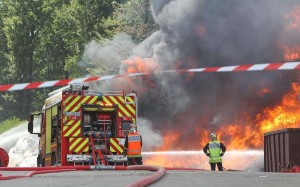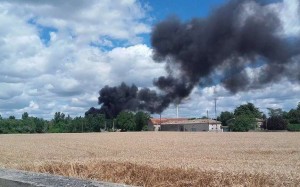At about 12:45 p.m., a fire broke out in a concrete storage cell of a waste transit and sorting centre. The fire spread to a bulk storage area containing 1,200 tonnes of paper, plastics, cardboard, metal objects and waste electrical and electronic equipment (WEEE). A large plume of black smoke was visible from several kilometres away.
The emergency rescue services evacuated the nearby waste disposal centre and incinerator; traffic was interrupted. An employee, having received 2nd-degree burns, was taken to the hospital. Firefighters encountered water supply difficulties because the site’s water reserve proved to be insufficient. They were forced to run water lines more than 1,500 m. The fire was contained after an hour and a half, but the waste was spread out and watered down for the next four days. The atmospheric measurements performed following the fire did not indicate any toxic risk. After the fire brigade had left, rounds were organised in the following days to check for the fire resuming.
Consequences
The fire burned 400 m³ of waste out of the 1,000 m³ present. The 600 m³ of extinguishing water used overflowed from the storage tank and infiltrated the ground at the site which was not hermetically sealed. Samples were taken from the environment to analyse the environmental impact.
Follow-up
A prefectoral emergency measures order was issued. The site was secured, and its activity was suspended. The baling activities for paper/cardboard and plastics was able to resume a few days later. Authorisation for the other activities was granted after the site had been redeveloped, fire residues disposed of and a fire protection system put in place.
Causal analysis
The inspection authorities for classified facilities noted several deviations from the regulations:
- the volume of waste stored was higher than the volume authorised;
- metal waste, ELVs and WEEE were stored without authorisation. This waste was removed from the site immediately;
- the storage conditions (quantities, minimum distances, and storage times) were not respected;
- the amount of water stored on site was insufficient.
A formal prefectoral notice was issued requiring the site to rectify its administrative situation. The site had already been given formal notice in the past due to unsafe operating conditions (excessive quantities stored, the presence of prohibited waste, and the layout of the storage facilities that did not allow the emergency services to access the property rapidly). A fire had already occurred at this site in 2008 (ARIA 34206).





